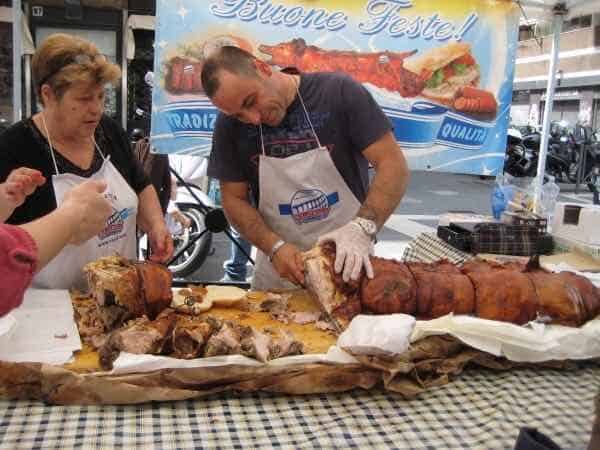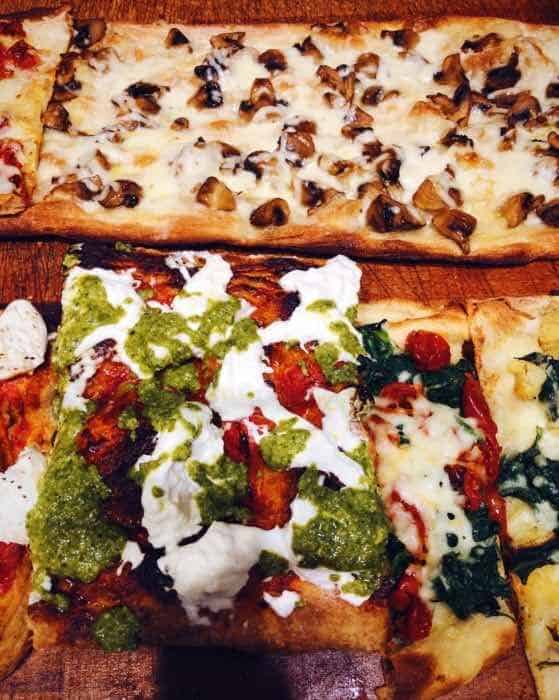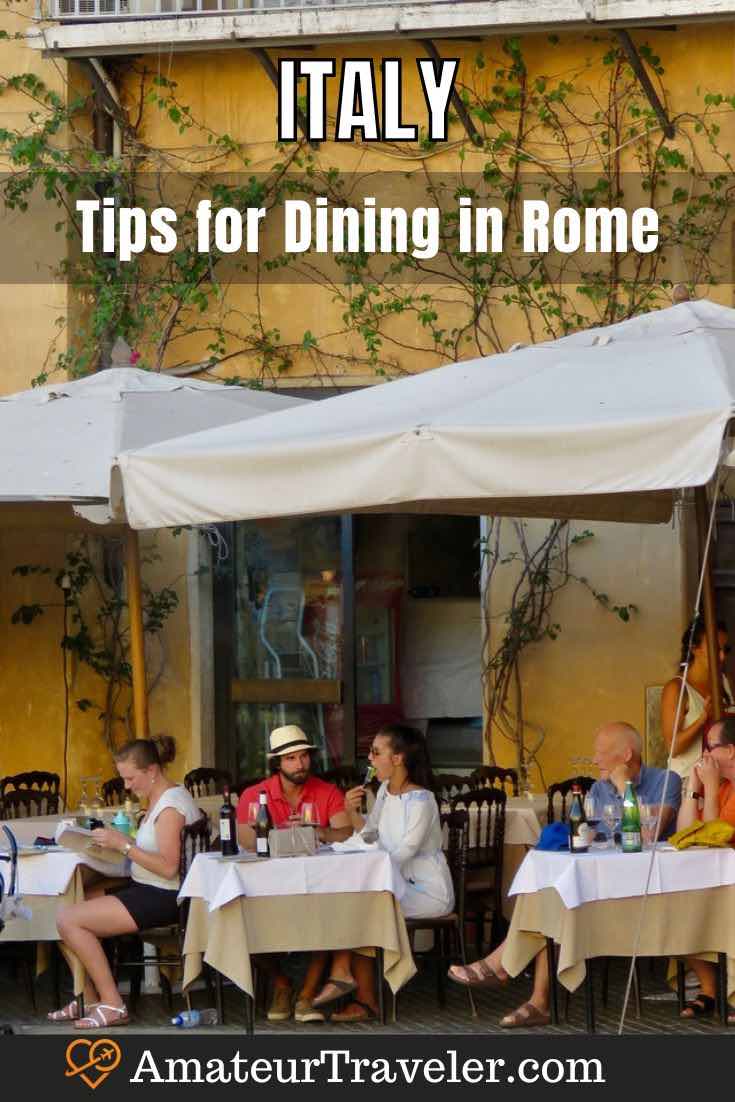Tips for Dining in Rome – When in Rome
categories: europe travelThey say, “When in Rome, do as the Romans do,” and that includes eating as the Romans eat. This famous Italian city has a rich culinary culture that you must experience during your visit.
If you’re going to travel all the way to Rome, you might as well experience some authentic Roman dining, right? Here is your ultimate guide to dining like a local in the City of Seven Hills.

ancient Fish sauce vendor sign Ostia Antica
Understanding Roman Cuisine
Let’s start by taking a trip back in time. To understand modern-day Roman cuisine, you must first understand ancient Roman culinary customs.
A Day in the Life
Archaeologists have determined that favorite Roman dishes included fattened snails, pigeons, shellfish, dormice, and various wild game. A typical day of eating in ancient Rome could be broken down as follows:
- Breakfast (ientaculum): Typically, a light meal of bread and fruit
- Mid-day meal (prandium): Fish, eggs, vegetables, or another cold snack
- Dinner (cena): A multi-course meal (including a sweet course), often featuring vegetable stews and oysters
- Comissation: Consumption of alcohol
- Vesperna: A light meal served before bed
Mealtimes revolved around ancient Romans’ daily schedules. For example, working-class Roman meals were organized around their workday and would typically include a mid-day meal to help them stave off hunger until cena. On the other hand, Wealthier Romans took care of their affairs in the morning and enjoyed cena earlier in the day, around 2 pm, after they visited the baths.
Favorite Beverages
Wine was, understandably, the go-to beverage among ancient Romans. It was usually mixed with water because, at the time, wine’s alcohol concentration was very high. Some of the most popular wines included passum, made from raisins, and mulsum, made from wine mixed with honey. Conditum was another well-loved drink made from wine, honey, and a variety of spices, such as pepper and saffron.
Rome’s Most Famous Ingredient
One of the most famous ingredients used in a variety of Roman dishes was known as garum. Garum was a fermented sauce made from fish (it was also popular in Ancient Greece, Phoenicia, Carthage, and Byzantium). Garum was made from fish intestines, which were fermented with salt to create a type of liquor. A fish paste called allex was a byproduct of this process. Poor Romans would even use it to add flavor to porridge.
Tips for Finding Authentic Roman Restaurants
When dining in Rome, you can find all kinds of restaurants serving everything from classic Italian cuisine to hamburgers and French fries. If you want to have an authentic Roman food experience, though, follow these guidelines:
Explore Backstreets and Outer Neighborhoods
As you stroll down the main streets of Rome — such as Via della Conciliazione, which takes you to the Vatican — you’ll find a bevy of restaurants worth checking out. If you want to experience more authentic cuisine, though, you’ll need to step off the beaten path. Explore backstreets and outer neighborhoods to find less tourist-centric establishments.
Be Wary of Hawkers
Many restaurants that cater to tourists have hawkers standing outside, attempting to lure people in. A good, authentic restaurant won’t need these kinds of gimmicks. Instead, it’ll rest on its delicious food and drinks alone.
Eat Like an Italian
You’re more likely to find a seat at traditional Roman restaurants if you dine on Roman time. Typically, that means eating lunch between 12:30 and 2:30 pm and then eating dinner around 9:00 pm. Many restaurants open for dinner around 7:00 or 7:30 pm, but those timeslots cater primarily to tourists and families.
Don’t Get Distracted by Flashy Exteriors
Similar to the point made above about hawkers, a good restaurant won’t have to tell you it’s good with flashy signs and catchy slogans. They’ll have a quiet confidence about them and will draw you in with their simple, modest interior and exterior decor.

Etiquette and Traditions in Roman Dining
You’ve found authentic Roman restaurants to try, but how do you dine like a real Roman? Here are some tips related to Roman dining etiquette and traditions to keep in mind:
Dress Appropriately
You don’t have to wear a tuxedo or an evening gown when eating out in Rome, but you also shouldn’t show up in your yoga pants or cargo shorts. Men generally do not wear shorts, regardless of the outdoor temperature, whereas women can typically get away with wearing shorts or skirts as long as they’re not too revealing.
Don’t Cut Your Pasta
Avoid cutting your pasta with a fork. Instead, twirl your fork against the side of the plate before taking a bite.
Enjoy Food as It’s Served
Generally, it’s best to eat your food as it’s served and listed on the menu. In other words, don’t ask for a dozen substitutions. If you do need a particular accommodation, such as a gluten-free meal, let your waiter know before you order.
Only Ask for Espresso
It’s common to drink coffee after lunch or dinner — but only order espresso. A cappuccino is typically considered a breakfast drink (although you can order it in the afternoon with a snack, not a meal). You’ll get a sideways glance if you ask for one following your lunch or dinner.
Bring Coins or Bills to Tip
Service is included in your restaurant bill, so it’s not necessary to tip. However, you can leave a few bills or coins behind if you enjoyed your service. Be sure to bring coins or bills because there is usually no option to add a tip when you pay with a credit card.
Must-Try Roman Dishes and Beverages
What should you order while on your Roman vacation? There are plenty of delicious drinks and dishes to enjoy during your visit, including the following:
Bruschetta
Pronounced “broo-sket-ah,” bruschetta shows up on many Roman restaurant menus. This simple dish features bread rubbed with garlic and drizzled with olive oil. One of the most popular varieties is bruschetta al pomodoro, served with diced tomatoes.
Pecorino Romano
Pecorino Romano is a hard, salty cheese made from sheep’s milk. It’s a staple in many Roman pasta dishes and is often offered instead of Parmigiano (parmesan).

Porchetta
Porchetta is beloved in Rome as well as Tuscany and Umbria. This dish features pork carved from a young pig and can be served at lunchtime as a Panino or as an antipasto (appetizer) at dinner.
Carciofi alla Giudia
Artichokes are popular vegetables throughout Italy, including Rome. There are two main ways to cook artichokes in Rome, including Carciofi alla Giudia, which translates to “Jewish artichokes.”
Many Roman foods have a strong Jewish influence, making this dish a must-try if you’re eager to sample authentic cuisine. Carciofi alla Giudia features deep-fried, crispy artichokes.
Carciofi alla Romana
The popular alternative to Carciofi all Giduia is Carciofi all Romana. These artichokes are slow-cooked and turn out tender and buttery.

Fiori di Zucca
Fiori di Zucca, or fried zucchini flowers, are featured in many Roman dishes. They can be served as a side dish or antipasto, but they may also be served on top of a pizza or pasta dish. Sometimes, these fried flowers are stuffed with mozzarella cheese and anchovies.
Fave al Guanciale
If you’re visiting Rome in the spring when they’re in season, you must try some fave beans (fava or broad beans). Fave al Guanciale is a frequently ordered side dish (contorno), featuring fave beans and pork jowl.

Pizza
Of course, you must sample some authentic Italian pizza during your trip to Rome. Remember that Roman pizza is thin and crispy — there’s no such thing as a deep-dish pizza here!
Bucatini
Bucatini means “little holes” and is a long, thick pasta with a tiny hole in the center. Buccatini is the pasta most frequently associated with Rome and, at the best restaurants, is freshly made in-house. Bucatini is typically used in the popular pasta dishes mentioned below: Pasta alla Gricia and Pasta alla Matriciana.
Pasta alla Gricia
Pasta alla Gricia is a simple Roman pasta featuring pecorino, black pepper, and pork jowl.
Pasta alla Matriciana
Pasta alla Matriciana is another classic Roman pasta dish also featuring pork jowl and pecorino, along with red peppers, tomatoes, a splash of wine, and a touch of garlic. This dish gets its name from Amatrice, a nearby town that is said to be its origin.
Pasta alla Carbonara
Pasta alla Carbonara in Roman is quite different from the carbonara you might enjoy in the States. It features a creamy sauce made from diced pork jowl, eggs, and pecorino or Parmigiano.
Spritzes
A spritz is a common aperitivo (pre-dinner drink) enjoyed throughout Italy, including Rome. The most prevalent version is an Aperol spritz, which features rhubarb-based liqueur combined with prosecco and club soda. It’s known for its bitter flavor and bright orange color.
Cocktails
If you’re not in the mood for a spritz, you can enjoy another cocktail as your pre-dinner drink. Try a negroni, which features gin, red vermouth, and Campari, or a negroni sbagliato, made with prosecco, Campari, and red vermouth. Most restaurants and bars have a list of specialty cocktails worth sampling, too.
Wine
As for drinks enjoyed with dinner, Italians typically limit themselves to water or wine (cocktails are meant to be aperitivos and often aren’t served alongside a meal). You’ll find plenty of wines to choose from, both red and white, but if you’re not sure what to pick, stick with something local to the region, as it will likely pair better with the meal’s flavors. Don’t be afraid to ask for a recommendation, either.
Navigating Dietary Preferences: Enjoying Roman Cuisine with Restrictions
Even with dietary restrictions, it’s easier than you might think to dine well in Rome. Remember these tips if you need to avoid gluten, dairy, etc.:
Download the AIC App
There’s an app for everything these days, including eating gluten-free while dining abroad.
The AIC app costs $2.99 for a two-week subscription. It provides access to a database of accredited gluten-free restaurants throughout Italy, including Rome.
Downloading this app makes it easy for you to find gluten-free options. It will also introduce you to various restaurants that might not have been on your radar otherwise!
Get an Italian Gluten-Free Dining Card
A dining card allows you to share your dietary needs with your waiter even if you don’t speak fluent Italian. Print an Italian gluten-free dining card before you leave (you can make your own or order one online). Italy has a high rate of celiac disease, so most Italians are familiar with the need for gluten-free options and are willing to accommodate.
Avoid Cream Sauces and Cheese-Based Dishes
If you don’t eat dairy, you have plenty of options in Rome (and the rest of Italy). Many pasta dishes are made without cheese, and olive oil is used more frequently than butter. Teach yourself the phrase “senza formaggio” (without cheese) to add to your order to be extra safe.
Consider Alternatives to Cow’s Milk
Keep in mind that some people are sensitive to dairy products made from cow’s milk but don’t have the same reaction to products from other animals’ milk. For example, pecorino is fine for many people because they aren’t as sensitive to sheep’s milk as cow’s.
Keep it Simple
It doesn’t matter if you’re dairy-free, gluten-free, vegan, or anything in between. The more straightforward dishes on the menu will be your best friends.
The good news is that many Italian dishes are surprisingly simple while also being packed with flavor, so you don’t have to sacrifice one for the other.
Where to Stay in Rome
| Hotel | rating | cost | ||
|---|---|---|---|---|
| Palazzo Ripetta | 9.5 | $$$$ | When money is no object | Book Now |
| Residenza Venti Settembre | 10 | $$ | Good reviews, good price | Book Now |
| Piccolotel | 9.5 | $ | breakfast included | Book Now |
| Adelante rooms | 9.6 | $$ | subway access | Book Now |

Culinary Conclusion: Embracing the Richness of Roman Gastronomy
A trip abroad is not complete without sampling some of the local cuisine. When in Rome, make sure to enjoy some of the classic dishes and drinks discussed in this guide, and don’t forget to follow our tips for enjoying Roman food with restrictions.
Do you have more tips for dining like a local in Rome? If so, drop them in the comments section below!
- Buy Travel Insurance
- Get an eSim to be able to use your smartphone abroad.
- Book Your Accommodation HERE
- Get a Car Rental
- Search for Great Tours HERE
- Get a universal plug adapter



 Travel to Rome, Italy – Episode 29
Travel to Rome, Italy – Episode 29 Top 10 Things to Do When in Rome, Italy
Top 10 Things to Do When in Rome, Italy Rome Walking Tour – A VIP tour of the Roman Colosseum, Palatine Hill and Forum (Review)
Rome Walking Tour – A VIP tour of the Roman Colosseum, Palatine Hill and Forum (Review) Rome Itinerary 5-Days with Family
Rome Itinerary 5-Days with Family
